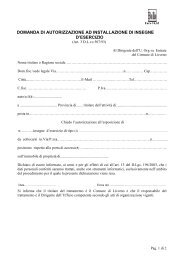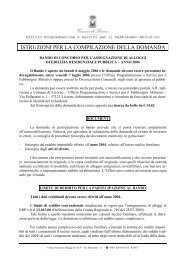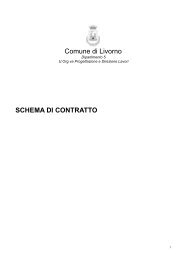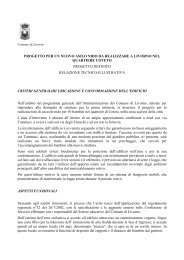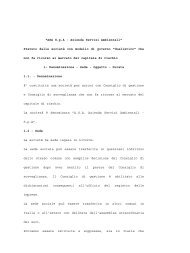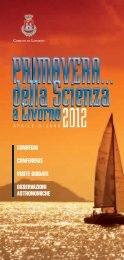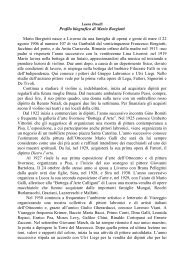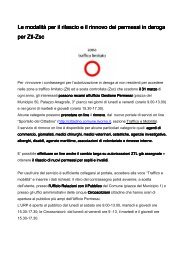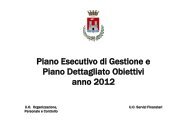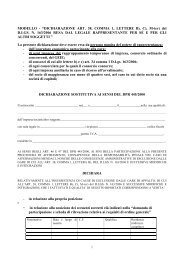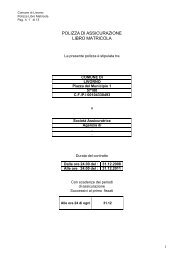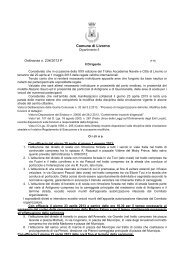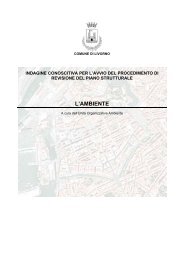Regolamento Comunale degli scarichi di acque reflue domestiche e ...
Regolamento Comunale degli scarichi di acque reflue domestiche e ...
Regolamento Comunale degli scarichi di acque reflue domestiche e ...
You also want an ePaper? Increase the reach of your titles
YUMPU automatically turns print PDFs into web optimized ePapers that Google loves.
COMUNE DI LIVORNO<br />
<strong>Regolamento</strong> <strong>degli</strong> <strong>scarichi</strong> <strong>di</strong> <strong>acque</strong> <strong>reflue</strong> <strong>domestiche</strong> e assimilate non recapitanti in pubblica fognatura e<br />
<strong>di</strong> <strong>acque</strong> meteoriche potenzialmente contaminate nella condotta bianca della pubblica fognatura<br />
escludendo dal computo le superfici coltivate; si considerano eventi meteorici <strong>di</strong>stinti quelli che si<br />
succedono a <strong>di</strong>stanza <strong>di</strong> quarantotto ore;<br />
j) Acque meteoriche <strong>di</strong>lavanti, AMD: <strong>acque</strong> derivanti da precipitazioni atmosferiche, che si<br />
<strong>di</strong>fferenziano in: <strong>acque</strong> meteoriche <strong>di</strong>lavanti non contaminate e <strong>acque</strong> meteoriche <strong>di</strong>lavanti<br />
contaminate<br />
k) Acque meteoriche <strong>di</strong>lavanti contaminate, AMDC: <strong>acque</strong> meteoriche <strong>di</strong>lavanti, <strong>di</strong>verse dalle <strong>acque</strong><br />
meteoriche <strong>di</strong>lavanti non contaminate, ivi incluse le <strong>acque</strong> meteoriche <strong>di</strong> prima pioggia derivanti<br />
dalle attività che comportano oggettivo rischio <strong>di</strong> trascinamento (nelle <strong>acque</strong> meteoriche) <strong>di</strong><br />
sostanze pericolose o <strong>di</strong> sostanze in grado <strong>di</strong> determinare effettivi pregiu<strong>di</strong>zi ambientali<br />
in<strong>di</strong>viduate nella Tab. 5 dell’allegato 5 del <strong>Regolamento</strong> 46/R e riportate nell’allegato 3 al<br />
presente <strong>Regolamento</strong>;<br />
l) Acque meteoriche <strong>di</strong>lavanti non contaminate, AMDNC: <strong>acque</strong> meteoriche <strong>di</strong>lavanti derivanti da<br />
superfici impermeabili non a<strong>di</strong>bite allo svolgimento <strong>di</strong> attività produttive, ossia: le strade<br />
pubbliche e private, i piazzali <strong>di</strong> sosta e <strong>di</strong> movimentazione <strong>di</strong> automezzi, parcheggi e similari,<br />
aree industriali dove non vengono svolte attività che possono oggettivamente comportare il rischio<br />
<strong>di</strong> trascinamento <strong>di</strong> sostanze pericolose o <strong>di</strong> sostanze in grado <strong>di</strong> determinare effettivi pregiu<strong>di</strong>zi<br />
ambientali; sono AMDNC anche le <strong>acque</strong> in<strong>di</strong>viduate ai sensi dell’art. 8, comma 8 della L.R., cioè<br />
le AMPP quando non siano entrate in contatto con altre <strong>acque</strong> e derivino:<br />
1) esclusivamente da tetti o tettoie <strong>di</strong> e<strong>di</strong>fici, <strong>di</strong> altre strutture permanenti o temporanee, <strong>di</strong><br />
inse<strong>di</strong>amenti o stabilimenti che non svolgano le attività <strong>di</strong> cui alla tab. 5 allegato 5 del<br />
<strong>Regolamento</strong> 46/R e riportate nell’allegato 3 al presente <strong>Regolamento</strong>;<br />
2) da altre superfici impermeabili, <strong>di</strong>verse da quelle al punto precedente, <strong>di</strong> stabilimenti che<br />
non svolgano le attività <strong>di</strong> cui alla tab. 5 allegato 5 del <strong>Regolamento</strong> 46/R e riportate<br />
nell’allegato 3 al presente <strong>Regolamento</strong>;<br />
m) Acque nere: <strong>acque</strong> <strong>reflue</strong> <strong>domestiche</strong>, assimilate a <strong>domestiche</strong> e industriali, <strong>di</strong>verse dalle <strong>acque</strong><br />
bianche;<br />
n) Acque per utilizzazione agronomica: effluenti <strong>di</strong> allevamento, <strong>acque</strong> <strong>di</strong> vegetazione residuate dalla<br />
lavorazione delle olive, ovvero <strong>acque</strong> <strong>reflue</strong> provenienti da aziende agricole e piccole aziende<br />
agroalimentari, dalla loro produzione all’applicazione al terreno <strong>di</strong> cui all’ art. 74, comma 1,<br />
lettera o) del Decreto;<br />
o) Acque <strong>reflue</strong> assimilate a <strong>domestiche</strong>: <strong>acque</strong> <strong>reflue</strong> provenienti da inse<strong>di</strong>amenti e/o stabilimenti <strong>di</strong><br />
cui alla Tab. 1 dell’allegato 2 al <strong>Regolamento</strong> 46/R e all’art. 101 comma 7 del Decreto, riportati<br />
nell’allegato 1 del presente <strong>Regolamento</strong>;<br />
6



